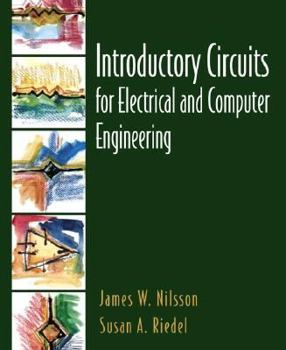Introductory Circuits for Electrical and Computer Engineering
Select Format
Select Condition 
Book Overview
Readers benefit because the book is based on these three themes: (1) it builds an understanding of concepts based on information the reader has previously learned; (2) it helps stress the relationship... This description may be from another edition of this product.
Format:Hardcover
Language:English
ISBN:0130198552
ISBN13:9780130198556
Release Date:October 2001
Publisher:Pearson
Length:555 Pages
Weight:2.55 lbs.
Dimensions:1.1" x 8.3" x 9.3"
Customer Reviews
2 ratings
A one-semester version of the most widely used introductory
Published by Thriftbooks.com User , 21 years ago
Circuits theory utilizes Kirchhoff's laws to find currents and potentials in any given network of electronic devices. It is essential not only for electrical and computer engineers. Electrical models describe many mechanical and biological systems and the skills of solving linear time invariant electronic circuits are similar to the skills required to solve any linear time invariant system, which is an essential skill for any engineer and rigorous scientists. This is currently the ultimate textbook about basic electronic circuits.It starts from the beginning, describes the basic circuits variables and elements, i.e., Voltage, Current sources and resistors and then shows the basic circuits analysis techniques and the general ones (Nodes and Mesh analysis). First only resistive circuits are used in order to establish the basic circuits analysis techniques and then Inductors and Capacitors are introduced with description of the transient step response and the steady state response with Phasors. Other chapters describe the op-amp and Laplace transform.Unfortunately the authors had chosen to sacrifice some important issues for the sake of simplicity: (1) Matrix notation is avoided and therefore one had to use tricks such as super-node in a section called "some special cases". The general methods with matrix notation (as developed in the good old texts of Desoer and Kuh) are important for computer implementation and moreover to prove the network theorems (Superposition Thevenin-Norton, Tellegen). (2) It is advisable to stress upfront that Kirchhoff's laws hold for lamped circuits and explain this notion. This is most important since modern electronic circuits work in high frequencies and in such cases the methods described in this book may not hold. (3) In the same way, many practical circuits are not linear and it should be clearly stated which method and technique hold also for nonlinear circuits. In the leading universities the instructors rigorously refer to the three points above and I hope that future editions of this text would include them either in the main text or as appendixes.This textbook is well pedagogically written with practical perspective at the beginning of each chapter to motivate the reader. It also includes exercises with Pspice and Matlab and problems with some partial numerical solutions. Altogether, this is a concise textbook, which is recommended as a one-semester textbook to achieve a basic appreciation of circuit theory and learn the essential skills required for any engineer and rigorous scientists.
The Best
Published by Thriftbooks.com User , 21 years ago
This is the best book for an introdutory course on electric circuits. I have taught and teach now using it. It presents the subjects in an adequate order, progressively increasing the difficulty level. Exercises are also very well formulated. It can be used also in disciplines like Electronics, System Analysis, Communication Systems.




